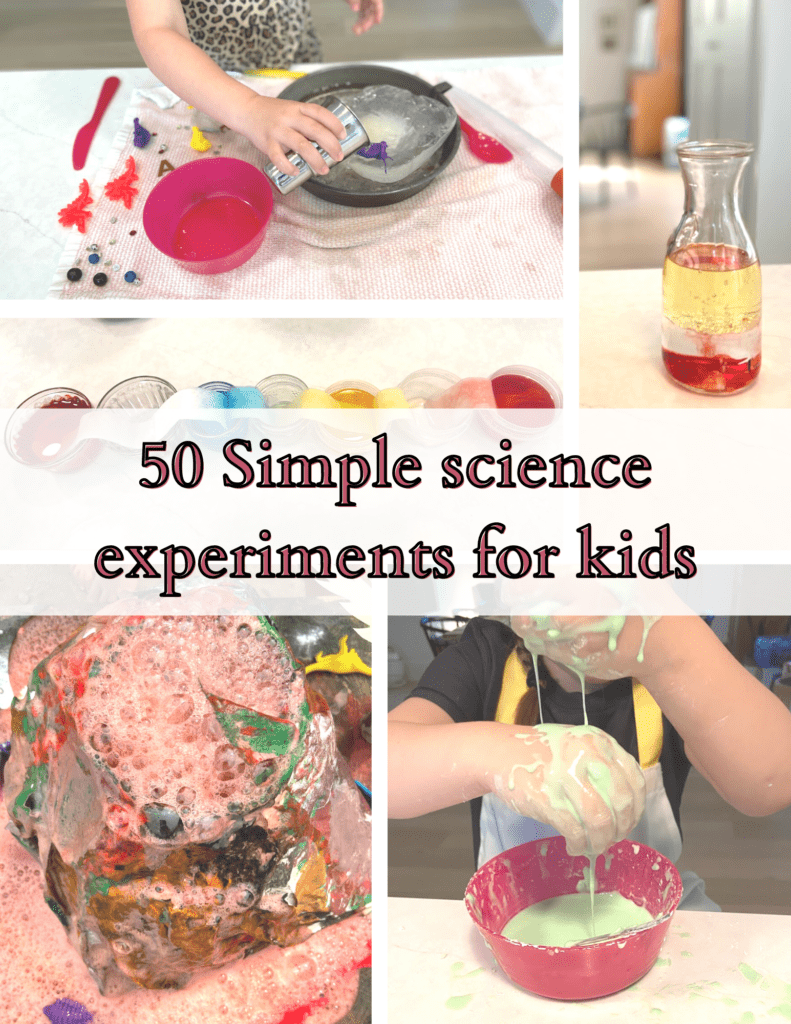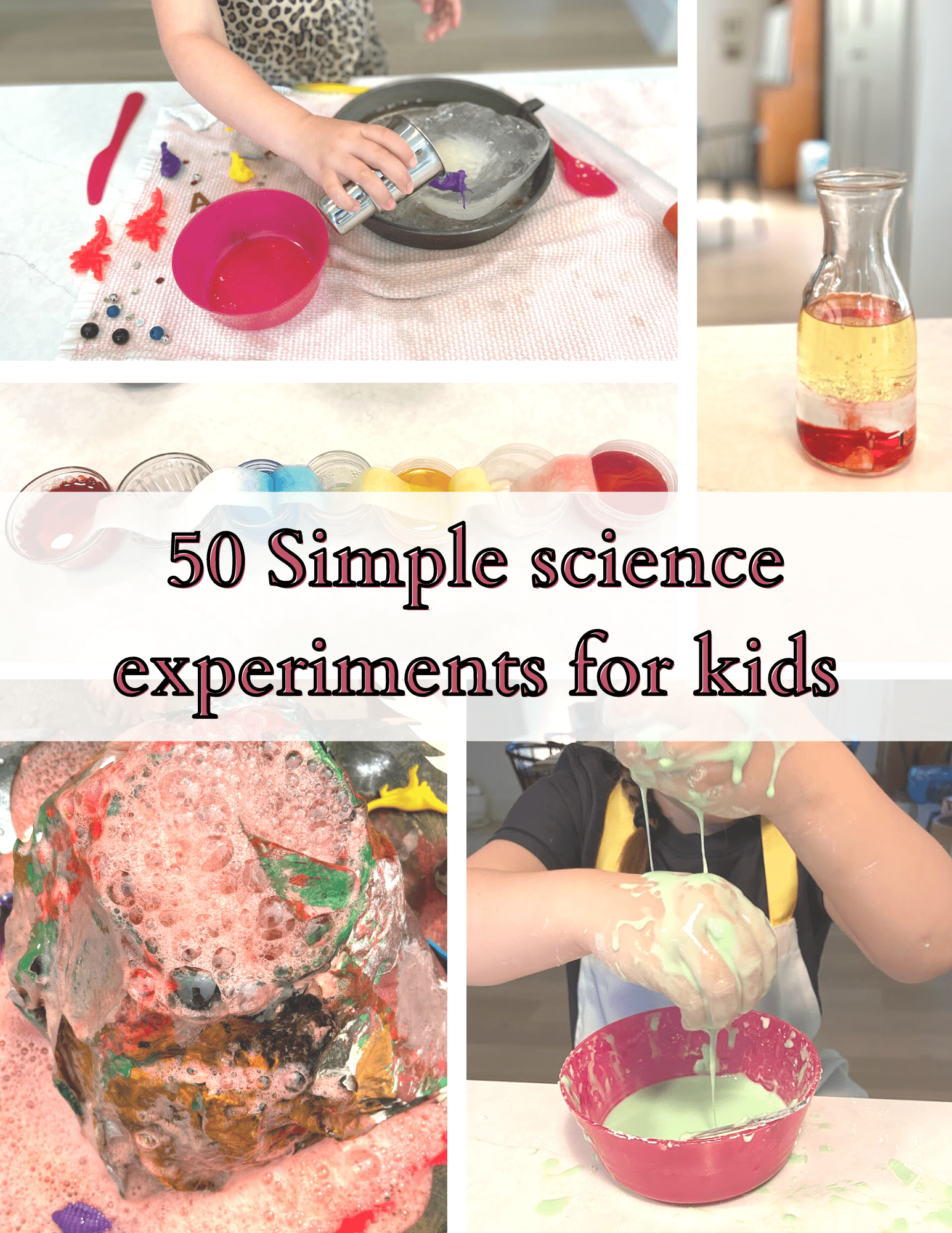We’ve compiled all of our favorite (and fun) science experiments for kids below. With a few simple ingredients or materials, your children can create cool projects and practice the scientific method with these easy science experiments.
Make sure there is always adult supervision when experimenting! Oh, and this is totally optional, but you may want to head over to my TpT store and download the Scientific Method worksheet for free. This way, you can emphasize key learning moments while introducing your children to the scientific method. By practicing this, they will become confident in their ability to hypothesize, test, and evaluate experiments!

If you’re looking for pre-school-appropriate science experiments, check out this post!
Easy science experiments: Grade K-2
First, earn why we think science for kids is so important in this post.
These super easy science experiments are great to teach simple science concepts to young learners! They’re grouped here because they require little adult support, but can also be done with older students. It all depends on how in-depth you want to get with the science!
And, many of them can be done with pre-k kids, too, as long as they are carefully supervised! They may not get the science behind it, but fostering a love of STEM is important, too.
1. Oobleck: Explore states of matter by creating this Non-newtonian fluid.
2. String telephone: This classic science experiment by Raising Lifelong Learners teaches how sound waves travel.
3. DIY dam: Think like a beaver and create your own dam as you explore environmental science with the PA Game Commission.
4. Popsicle stick catapult: Teach kids about STEM with Little Bins for Little Hands. All you need is popsicle sticks, a rubber band or two, a plastic spoon, and something to launch!
5. Walking water experiment: The science of color theory and capillary action meet to create your own rainbow in this classic experiment for kids.
6. Grow a windowsill garden: Prep seedlings before spring planting (or just grow plants indoors!). All you need is an empty bottle or some egg cartons for this activity by GrowVeg.
7. Learn about seed germination: Or, skip the dirt and watch the seeds germinate in this activity by Scholastic!
8. Make your own rock candy: Science and a snack? Nice! We Are Not Martha shows how to watch the crystalization process over the few days it takes to make this cool treat.
9. Pepper and soap experiment: I’ve used this as a way to demonstrate how dish soap (or hand soap) repels germs and as an explanation for surface tension. Starhop uses it to demonstrate the hydrophobic nature of pepper. *See #19 for more surface tension experiments!
10. DIY volcano: A baking soda volcano is one of my favorite science experiments (and the kid’s, too!). See how we made ours with paper maché here.
11. Ice cream in a bag: Kitchen science experiments have never been this fun! Watch states of matter change before your eyes as you make your own ice cream with Delish.
12. Write secret messages: Science Buddies shows us how to create invisible ink using basic supplies like lemon juice, turmeric, and baking soda.
13. Static electricity butterflies: Explore static electricity in this super easy science experiment by following along with our tutorial here.
14. Homemade sundial: Demonstrate how the sun moves throughout the day by tracking it as you build this super easy sundial with The Winkle.
15. Shadow drawing: This is another really easy way to teach your child about shadows. Plus it’s a fun art project! See how we did it here.
16. Float or sink: All you have to do for this is gather supplies and fill a tub with water… Then test what sinks or floats! This is an easy way to practice hypothesizing, observing, and testing.
17. Buoyancy testing: See if you can make a fresh egg float by increasing the density of water with salt. Simply place the egg in a glass of water and keep adding – Track how much. Can you make other things float that would usually sink? (if you put an egg in water and it floats without salt… It’s bad!)
18. Color-changing flowers: Gather some flowers and leaves from the garden and see if you can change their color over a few hours by adding food coloring to their water. This shows how plants drink via capillary action… But be sure to gather a variety, because not all will change color!
19. Surface tension with soap: This video by the Science Factory gives 8 experiments for teaching kids about surface tension using basic materials.
20. Disappearing egg shell: Create a bouncing egg with just eggs and vinegar! The Indianapolis Public Library suggests you test three different eggs to see which bounces best… Just make sure to test outside…
21. Coffee ground fossils: These cute no-bake fossils by Crafts by Amanda are a fun entry-level activity for learning about fossilization… And you can make them into cute ornaments, too.
22. Melting rates with colors: See how different colors affect the melting rate of ice with this easy science experiment. Curiodyssey has a quick tutorial here!
23. DIY anemometer: Learn about wind speed and pressure with this easy DIY Project!
24. Ice excavation: Need a science activity for a hot summer’s day? Freeze some objects into a block of ice and challenge your children to uncover them in this simple experiment.
25. Candy engineering: Put your child’s engineering skills to the test as they design, build, and test structures built with toothpicks and candy… Then enjoy a yummy treat at the end!
26. Soap soufflé: If you’ve got Ivory soap on hand, you can microwave it to watch it expand as the soap melts and the air bubbles expand! Plus, you can use it after (and soap soufflé is way more fun than regular soap…). Da Vinci Kids shows you how to create it here.
27. Regrow food clippings: Learn about a plant’s life cycle by seeing if you can regrow kitchen cuttings. Most of us know you can regrow green onions… But what else can you grow?
28. DIY lava lamp: Watch chemical reactions happen as carbon dioxide is created by Alka-seltzer and water interacting together. A few drops of color and some vegetable oil turn the reaction into a homemade lava lamp! Learn how here.
29. Homemade rain gauge: Teach your kiddos about the water cycle with this fun science experiment. I’ll teach you how to make your own rain gauge here.
Fun science experiments: Grade 3-6
These experiments either require more abstract concepts or require more precise measuring and designing. While some could probably be done with younger kids, students in grades 3-6 will better understand the science behind what’s happening! Just be sure to carefully supervise and modify the experiments if you choose to use them for a different age range of children.
30. Self-inflating balloon: Education.com shows us what happens when you mix an acid and a base in this easy science experiment for kids. Such simple chemistry!
31. Make your own fossil: The no-bake fossils above are cool, but this one by Planet Science uses plaster of Paris to create a life-like looking fossil. I’ve also heard that if you brush it with cold coffee when it’s dry that it looks even more realistic.
32. Backward ice melt race: Design your own insulator (and test it) to see who can keep the ice cube from melting the longest with the Lunar and Planetary Institute.
33. Egg drop challenge: Calling all engineers! Can you design something that would have saved Humpty Dumpty back in the day? MSI will guide you through this cool project.
34. Experiment with plant filtration: Demonstrate the importance of plants in water filtration with this easy experiment by Edmonton & Area Land Trust.
35. Build your own Rube Goldberg machine: Because why simply ring a bell when you can create an overly-complicated machine to do it for you? Use Joseph Herscher‘s wild inventions as inspiration and see if you can create your own!
36. DIY pendulum painting: So, this one could get messy… But if you’ve got an artsy engineer like J Mo Painting, then they will love this! It’s a beautiful way to explore inertia and motion.
37. DIY Water wheel: Looking for a fun science project? Try making this water wheel with Million Gears.
38. DIY handmade paper: Create your own paper for journaling or drawing with Vijayta Sharma. This tutorial doesn’t require the frame, either!
39. Balloon rockets: The Dad Lab has a quick tutorial for making balloon rockets. These are definitely easy enough to make with young children, but it’s great for teaching older students about Newton’s laws of motion and air pressure.
40. Slime: Same as #39… Littles will enjoy this too, and you could use it in a states of matter lesson, but you can also use it to teach about polymers and viscosity, like Slimy Science! suggests.
41. Vibrating molecules: This Generation Genius tutorial is a great hook lesson for thermal energy. Plus, all you need is food coloring and water.
42. Solar oven: Use solar power to create delicious S’mores treats by creating this fun solar oven by Little Passports.
43. DIY seismograph: A real-life seismograph is not cheap… So next time you’re teaching earth science, get the kids to create their own! Science World has an awesome tutorial.
44. Paper plane challenge: Are your kids learning about aerodynamics? Challenge them to design and test a paper plane!
45. DIY paper plane launcher: Launch your paper airplane even farther with this cool DIY from Frugal Fun.
46. Extract iron from cereal: We all need iron in our bodies to help transport oxygen from our lungs. But did you know that you can actually see it if you hold a magnet to it? Science Focus shows you how!
47. Thermal energy transfer with balloons: Try blowing up a balloon and holding it over a candle flame. It probably won’t take long to pop, right? But what happens when you put water into it? The water can hold thermal energy – Preventing the balloon from popping! Give it a try.
48. Simple motor DIY: With just a few materials, Generation Genius shows you how to create a self-propelling simple motor.
49. Saltwater density layers: Different liquids have different densities… But did you know that you can add salt to colored water to create a layered water effect? Whiz Kid Science shows you how to make a density tower (they also do one with different liquids).
50. Grow your own mineral crystals: Teach your students about recrystallization, saturated solutions, and solubility with Little Bins for Little Hands. Since children should not ingest Borax, I put it on the list for older ones. With careful supervision, you could probably do this with younger kids though.
Conclusion
What are your favorite science experiments for kids? We would love to see what you’ve created!
Science experiments like the ones listed in this article are a great way to teach kids about the scientific method while learning essential STEM-related skills. Plus, what better way to explore and understand the world around us than testing a cool experiment?!
Young kids will love the easy experiments we listed in the first half, whereas older kids can explore cool science experiments in more depth.
More science posts
Searching for more science experiments and science-related activities to do with your little ones? Check out this category to see all of our posts about science for kids!


Leave a Reply